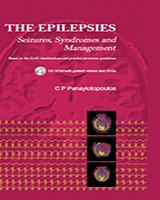From: Chapter 10, Idiopathic Generalised Epilepsies

NCBI Bookshelf. A service of the National Library of Medicine, National Institutes of Health.

Top: The EEG showed electrical status epilepticus during wakefulness and sleep. This consisted of nearly continuous generalised discharges of spikes (or double spikes) and slow wave complexes at 2.5–3Hz. This pattern occasionally alternated with relatively normal background activity lasting less than 30 s. The main clinical manifestations were frequent facial subtle myoclonias (eyelid fluttering, upwards deviation of the eyes with spontaneous eye opening associated with fast eyelid fluttering, subtle facial twitches) and a few massive myoclonic jerks occasionally with some atonic components. Clinically, there was no apparent impairment of consciousness.
Middle: Details of the EEG in the top of the Figure. Magnified frontal EEG channels and increased time scale.
Bottom: The video EEG 1 month later was normal during wakefulness with a few myoclonic jerks only during sleep.
From: Chapter 10, Idiopathic Generalised Epilepsies

NCBI Bookshelf. A service of the National Library of Medicine, National Institutes of Health.